Exploring the Formation Mechanism of Unsafe Construction Behavior and Testing Efficient Occupational Health and Safety (OHS) Programs
Abstract
1. Introduction
2. Literature Review
2.1. Safety Training and Safety Performance
2.2. Causes Affecting Safety Performance
3. Formation Mechanism of Unsafe Behaviors of Construction Workers
4. Methodology
4.1. Content Design for OHS Trainings and Education
4.2. Design of Training Frequency and Number of Training for Safety Behavior
4.2.1. Simple Safety Behavior
4.2.2. Complex Safety Behavior
5. Results and Discussion
5.1. Generalized Model of Training Frequency and Number of Trainings
5.1.1. Training Frequency and Number of Trainings for Simple Safety Behavior
5.1.2. Training Frequency and Number of Trainings for Complex Safety Behaviors
5.2. Practical Safety Performance Experiments
5.2.1. Construction Helmet-Wearing Experiment
5.2.2. On-Site Construction Fire Drill Experiment
6. Conclusions
Author Contributions
Funding
Institutional Review Board Statement
Informed Consent Statement
Data Availability Statement
Acknowledgments
Conflicts of Interest
References
- Li, Q.; Ji, C.; Yuan, J.; Han, R. Developing dimensions and key indicators for the safety climate within China’s construction teams: A questionnaire survey on construction sites in Nanjing. Saf. Sci. 2017, 93, 266–276. [Google Scholar] [CrossRef]
- Hoła, B.; Nowobilski, T. Analysis of the Influence of Socio-Economic Factors on Occupational Safety in the Construction Industry. Sustainability 2019, 11, 4469. [Google Scholar] [CrossRef]
- Li, L. China’s manufacturing locus in 2025: With a comparison of “Made-in-China 2025” and “Industry 4.0”. Technol. Forecast. Soc. Chang. 2018, 135, 66–74. [Google Scholar] [CrossRef]
- Başağa, H.B.; Temel, B.A.; Atasoy, M.; Yıldırım, I. A study on the effectiveness of occupational health and safety trainings of construction workers in Turkey. Saf. Sci. 2018, 110, 344–354. [Google Scholar] [CrossRef]
- Choi, S.D.; Guo, L.; Kim, J.; Xiong, S. Comparison of fatal occupational injuries in construction industry in the United States, South Korea, and China. Int. J. Ind. Erg. 2019, 71, 64–74. [Google Scholar] [CrossRef]
- Kang, L.; Wu, C.; Liao, X.; Wang, B. Safety performance and technology heterogeneity in China’s provincial construction industry. Saf. Sci. 2020, 121, 83–92. [Google Scholar] [CrossRef]
- Khan, M.W.; Ali, Y.; De Felice, F.; Petrillo, A. Occupational health and safety in construction industry in Pakistan using modified-SIRA method. Saf. Sci. 2019, 118, 109–118. [Google Scholar] [CrossRef]
- Loosemore, M.; Malouf, N. Safety training and positive safety attitude formation in the Australian construction industry. Saf. Sci. 2019, 113, 233–243. [Google Scholar] [CrossRef]
- Lozano-Díez, R.V.; López-Zaldívar, O.; del Cura, S.H.; Verdú-Vázquez, A. Analysis of the impact of health and safety coordinator on construction site accidents: The case of Spain. J. Saf. Res. 2019, 68, 149–156. [Google Scholar] [CrossRef]
- Manu, P.; Poghosyan, A.; Mshelia, I.M.; Iwo, S.T.; Mahamadu, A.-M.; Dziekonski, K. Design for occupational safety and health of workers in construction in developing countries: A study of architects in Nigeria. Int. J. Occup. Saf. Erg. 2019, 25, 99–109. [Google Scholar] [CrossRef]
- Okorie, V.N.; Musonda, I. An investigation on supervisor’s ability and competency to conduct construction site health and safety induction training in Nigeria. Int. J. Constr. Manag. 2018, 20, 357–366. [Google Scholar] [CrossRef]
- Antwi-Afari Maxwell, F. Sensing and warning-based technology applications to improve occupational health and safety in the construction industry: A literature review. Eng. Constr. Architect. Manag. 2019, 26, 1534–1552. [Google Scholar] [CrossRef]
- Gao, Y.; Gonzalez, V.A.; Yiu, T.W. The effectiveness of traditional tools and computer-aided technologies for health and safety training in the construction sector: A systematic review. Comput. Educ. 2019, 138, 101–115. [Google Scholar] [CrossRef]
- Bluff, E. How SMEs respond to legal requirements to provide information, training, instruction and supervision to workers about work health and safety matters. Saf. Sci. 2019, 116, 45–57. [Google Scholar] [CrossRef]
- Poghosyan, A.; Manu, P.; Mahamadu, A.-M.; Akinade, O.; Mahdjoubi, L.; Gibb, A.; Behm, M. A web-based design for occupational safety and health capability maturity indicator. Saf. Sci. 2020, 122, 104516. [Google Scholar] [CrossRef]
- Jaafar, M.H.; Arifin, K.; Aiyub, K.; Razman, M.R.; Ishak, M.I.S.; Samsurijan, M.S. Occupational safety and health management in the construction industry: A review. Int. J. Occup. Saf. Erg. 2018, 24, 493–506. [Google Scholar] [CrossRef]
- Niu, Y.; Lu, W.; Xue, F.; Liu, D.; Chen, K.; Fang, D.; Anumba, C. Towards the “third wave”: An SCO-enabled occupational health and safety management system for construction. Saf. Sci. 2019, 111, 213–223. [Google Scholar] [CrossRef]
- Newnam, S.; Goode, N. Communication in the workplace: Defining the conversations of supervisors. J. Saf. Res. 2019, 70, 19–23. [Google Scholar] [CrossRef]
- Tam, V.W.Y.; Fung, I.W.H. Behavior, Attitude, and Perception toward Safety Culture from Mandatory Safety Training Course. J. Prof. Issues Eng. Educ. Pract. 2012, 138, 207–213. [Google Scholar] [CrossRef]
- Xu, S.; Zhang, M.; Hou, L. Formulating a learner model for evaluating construction workers’ learning ability during safety training. Saf. Sci. 2019, 116, 97–107. [Google Scholar] [CrossRef]
- Guo, S.; He, J.; Li, J.; Tang, B. Exploring the Impact of Unsafe Behaviors on Building Construction Accidents Using a Bayesian Network. Int. J. Env. Res. Public Health 2019, 17, 221. [Google Scholar] [CrossRef]
- Khosravi, Y.; Asilian-Mahabadi, H.; Hajizadeh, E.; Hassanzadeh-Rangi, N.; Bastani, H.; Behzadan, A.H. Factors Influencing Unsafe Behaviors and Accidents on Construction Sites: A Review. Int. J. Occup. Saf. Erg. 2014, 20, 111–125. [Google Scholar] [CrossRef] [PubMed]
- Robson, L.S.; Stephenson, C.M.; A Schulte, P.; Amick, B.C.I.; Irvin, E.L.; E Eggerth, D.; Chan, S.; Bielecky, A.R.; Wang, A.M.; Heidotting, T.L.; et al. A systematic review of the effectiveness of occupational health and safety training. Scand. J. Work. Env. Health 2011, 38, 193–208. [Google Scholar] [CrossRef]
- Liang, K.; Fung, I.W.H.; Xiong, C.; Luo, H. Understanding the Factors and the Corresponding Interactions That Influence Construction Worker Safety Performance from a Competency-Model-Based Perspective: Evidence from Scaffolders in China. Int. J. Env. Res. Public Health 2019, 16, 1885. [Google Scholar] [CrossRef]
- Marín, L.S.; Roelofs, C. Promoting Construction Supervisors’ Safety-Efficacy to Improve Safety Climate: Training Intervention Trial. J. Constr. Eng. Manag. 2017, 143, 04017037. [Google Scholar] [CrossRef]
- Teizer, J.; Cheng, T.; Fang, Y. Location tracking and data visualization technology to advance construction ironworkers’ education and training in safety and productivity. Autom. Constr. 2013, 35, 53–68. [Google Scholar] [CrossRef]
- Al-Bayati, A.J. Satisfying the Need for Diversity Training for Hispanic Construction Workers and Their Supervisors at US Construction Workplaces: A Case Study. J. Constr. Eng. Manag. 2019, 145, 05019007. [Google Scholar] [CrossRef]
- Bhandari, S.; Hallowell, M.R.; Correll, J. Making construction safety training interesting: A field-based quasi-experiment to test the relationship between emotional arousal and situational interest among adult learners. Saf. Sci. 2019, 117, 58–70. [Google Scholar] [CrossRef]
- Hashem MMehany, M.S.; Killingsworth, J.; Shah, S. An Evaluation of Training Delivery Methods’ Effects on Construction Safety Training and Knowledge Retention - A Foundational Study. Int. J. Constr. Educ. Res. 2021, 17, 18–36. [Google Scholar] [CrossRef]
- Liu, D.; Gambatese, J. Student Education and Training Needs for Safety in Roadway Engineering Fieldwork. J. Prof. Issues Eng. Educ. Pr. 2018, 144, 04018012. [Google Scholar] [CrossRef]
- Bhandari, S.; Hallowell, M.R. Emotional Engagement in Safety Training: Impact of Naturalistic Injury Simulations on the Emotional State of Construction Workers. J. Constr. Eng. Manag. 2017, 143, 04017090. [Google Scholar] [CrossRef]
- Fargnoli, M.; Lombardi, M. Preliminary Human Safety Assessment (PHSA) for the Improvement of the Behavioral Aspects of Safety Climate in the Construction Industry. Buildings 2019, 9, 69. [Google Scholar] [CrossRef]
- Michaelis, M.; Balint, E.M.; Junne, F.; Zipfel, S.; Gündel, H.; Lange, R.; Rieger, M.A.; Rothermund, E. Who Should Play a Key Role in Preventing Common Mental Disorders that Affect Employees in the Workplace? Results of a Survey with Occupational Health Physicians, Primary Care Physicians, Psychotherapists, and Human Resource Managers. Int. J. Env.. Res. Public Health 2019, 16, 1383. [Google Scholar] [CrossRef]
- Vignoli, M.; Nielsen, K.; Guglielmi, D.; Mariani, M.G.; Patras, L.; Peirò, J.M. Design of a safety training package for migrant workers in the construction industry. Saf. Sci. 2021, 136, 105124. [Google Scholar] [CrossRef]
- Gunduz, M.; Ahsan, B. Construction safety factors assessment through Frequency Adjusted Importance Index. Int. J. Ind. Erg. 2018, 64, 155–162. [Google Scholar] [CrossRef]
- Dawood, N.; Miller, G.; Patacas, J.; Kassem, M. Combining Serious Games and 4D Modelling for Construction Health and Safety Training. In Computing in Civil and Building Engineering (2014); American Society of Civil Engineers (ASCE): Reston, VA, USA, 2014; pp. 2087–2094. [Google Scholar]
- Kozlovska, M.; Struková, Z. Multimedia Educational Programs for Improvement of Occupational Safety Awareness in Construction Industry. Procedia Soc. Behav. Sci. 2013, 106, 1866–1875. [Google Scholar] [CrossRef][Green Version]
- Sukamani, D.; Wang, J.; Kusi, M. Impact of Safety Worker Behavior and Safety Climate as Mediator and Safety Training as Moderator on Safety Performance in Construction Firms in Nepal. Ksce J. Civ. Eng. 2021, 25, 1555–1567. [Google Scholar] [CrossRef]
- Choudhry, R.; Fang, D.; Mohamed, S. The nature of safety culture: A survey of the state-of-the-art. Saf. Sci. 2007, 45, 993–1012. [Google Scholar] [CrossRef]
- Cavazza, N.; Serpe, A. The impact of safety training programs on workers’ psychosocial orientation and behaviour. Revue Int. Psychol. Soc. 2010, 23, 187–210. [Google Scholar]
- Griffin, M.A.; Neal, A. Perceptions of safety at work: A framework for linking safety climate to safety performance, knowledge, and motivation. J. Occup. Health Psychol. 2000, 5, 347–358. [Google Scholar] [CrossRef] [PubMed]
- Mearns, K.; Hope, L.; Ford, M.T.; Tetrick, L.E. Investment in workforce health: Exploring the implications for workforce safety climate and commitment. Accid. Anal. Prev. 2010, 42, 1445–1454. [Google Scholar] [CrossRef] [PubMed]
- Cagno, E.; Micheli, G.J.L.; Jacinto, C.; Masi, D. An interpretive model of occupational safety performance for Small- and Medium-sized Enterprises. Int. J. Ind. Erg. 2014, 44, 60–74. [Google Scholar] [CrossRef]
- Chan, A.P.C.; Yang, Y.; Darko, A. Construction Accidents in a Large-Scale Public Infrastructure Project: Severity and Prevention. J. Constr. Eng. Manag. 2018, 144, 05018010. [Google Scholar] [CrossRef]
- Wang, B.; Wu, C.; Kang, L.; Reniers, G.; Huang, L. Work safety in China’s Thirteenth Five-Year plan period (2016–2020): Current status, new challenges and future tasks. Saf. Sci. 2018, 104, 164–178. [Google Scholar] [CrossRef]
- Feng, Y.; Teo, E.A.L.; Ling, F.Y.Y.; Low, S.P. Exploring the interactive effects of safety investments, safety culture and project hazard on safety performance: An empirical analysis. Int. J. Proj. Manag. 2014, 32, 932–943. [Google Scholar] [CrossRef]
- Hare, B.; Cameron, I. Site manager safety training. Eng. Constr. Arch. Manag. 2011, 18, 568–578. [Google Scholar] [CrossRef]
- Namian, M.; Albert, A.; Zuluaga, C.M.; Jaselskis, E.J. Improving Hazard-Recognition Performance and Safety Training Outcomes: Integrating Strategies for Training Transfer. J. Constr. Eng. Manag. 2016, 142, 04016048. [Google Scholar] [CrossRef]
- Liao, C.-W. Pattern Analysis of Seasonal Variation in Occupational Accidents in the Construction Industry. Procedia Eng. 2012, 29, 3240–3244. [Google Scholar] [CrossRef]
- Shao, B.; Hu, Z.; Liu, Q.; Chen, S.; He, W. Fatal accident patterns of building construction activities in China. Saf. Sci. 2019, 111, 253–263. [Google Scholar] [CrossRef]
- El-Mashaleh, M.S.; Rababeh, S.M.; Hyari, K.H. Utilizing data envelopment analysis to benchmark safety performance of construction contractors. Int. J. Proj. Manag. 2010, 28, 61–67. [Google Scholar] [CrossRef]
- Bavafa, A.; Mahdiyar, A.; Marsono, A.K. Identifying and assessing the critical factors for effective implementation of safety programs in construction projects. Saf. Sci. 2018, 106, 47–56. [Google Scholar] [CrossRef]
- Schwatka, N.V.; Hecker, S.; Goldenhar, L.M. Defining and Measuring Safety Climate: A Review of the Construction Industry Literature. Ann. Occup. Hyg. 2016, 60, 537–550. [Google Scholar] [CrossRef]
- Kim, N.K.; Rahim, N.F.A.; Iranmanesh, M.; Foroughi, B. The role of the safety climate in the successful implementation of safety management systems. Saf. Sci. 2019, 118, 48–56. [Google Scholar] [CrossRef]
- Akram, R.; Thaheem, M.J.; Nasir, A.R.; Ali, T.H.; Khan, S. Exploring the role of building information modeling in construction safety through science mapping. Saf. Sci. 2019, 120, 456–470. [Google Scholar] [CrossRef]
- Fang, W.; Ding, L.; Love, P.E.; Luo, H.; Li, H.; Peña-Mora, F.; Zhong, B.; Zhou, C. Computer vision applications in construction safety assurance. Autom. Constr. 2020, 110, 103013. [Google Scholar] [CrossRef]
- Sacks, R.; Perlman, A.; Barak, R. Construction safety training using immersive virtual reality. Constr. Manag. Econ. 2013, 31, 1005–1017. [Google Scholar] [CrossRef]
- Zhou, Z.; Goh, Y.M.; Li, Q. Overview and analysis of safety management studies in the construction industry. Saf. Sci. 2015, 72, 337–350. [Google Scholar] [CrossRef]
- Jeelani, I.; Albert, A.; Azevedo, R.; Jaselskis, E.J. Development and Testing of a Personalized Hazard-Recognition Training Intervention. J. Constr. Eng. Manag. 2017, 143, 04016120. [Google Scholar] [CrossRef]
- Mahabadi, H.A.; Khosravi, Y.; Hassanzadeh-Rangi, N.; Hajizadeh, E.; Behzadan, A.H. Factors affecting unsafe behavior in construction projects: Development and validation of a new questionnaire. Int. J. Occup. Saf. Erg. 2020, 26, 219–226. [Google Scholar] [CrossRef]
- Seo, H.-C.; Lee, Y.; Kim, J.-J.; Jee, N.-Y. Analyzing safety behaviors of temporary construction workers using structural equation modeling. Saf. Sci. 2015, 77, 160–168. [Google Scholar] [CrossRef]
- Wilkins, J.R. Construction workers’ perceptions of health and safety training programmes. Constr. Manag. Econ. 2011, 29, 1017–1026. [Google Scholar] [CrossRef]
- Hossain, M.A.; Abbott, E.L.; Chua, D.K.; Nguyen, T.Q.; Goh, Y.M. Design-for-Safety knowledge library for BIM-integrated safety risk reviews. Autom. Constr. 2018, 94, 290–302. [Google Scholar] [CrossRef]
- Al-Refaie, A. Factors affect companies’ safety performance in Jordan using structural equation modeling. Saf. Sci. 2013, 57, 169–178. [Google Scholar] [CrossRef]
- Patel, D.; Jha, K. Structural equation modeling for relationship-based determinants of safety performance in construction projects. J. Manag. Eng. 2016, 32, 05016017. [Google Scholar] [CrossRef]
- Kang, Y.; Siddiqui, S.; Suk, S.J.; Chi, S.; Kim, C. Trends of Fall Accidents in the U.S. Construction Industry. J. Constr. Eng. Manag. 2017, 143, 04017043. [Google Scholar] [CrossRef]
- He, C.; Jia, G.; McCabe, B.; Chen, Y.; Sun, J. Impact of psychological capital on construction worker safety behavior: Communication competence as a mediator. J. Saf. Res. 2019, 71, 231–241. [Google Scholar] [CrossRef]
- Newaz, M.T.; Davis, P.; Jefferies, M.; Pillay, M. Role of Psychological Contract to Influence Safety Behaviour at Construction Sites; Springer Science and Business Media LLC: Berlin, Germany, 2018; pp. 545–555. [Google Scholar]
- Idrees, M.D.; Hafeez, M.; Kim, J.-Y. Workers’ Age and the Impact of Psychological Factors on the Perception of Safety at Construction Sites. Sustainability 2017, 9, 745. [Google Scholar] [CrossRef]
- Newaz, M.T.; Davis, P.; Jefferies, M.; Pillay, M. The psychological contract: A missing link between safety climate and safety behaviour on construction sites. Saf. Sci. 2019, 112, 9–17. [Google Scholar] [CrossRef]
- Shen, Y.; Ju, C.; Koh, T.Y.; Rowlinson, S.; Bridge, A.J. The Impact of Transformational Leadership on Safety Climate and Individual Safety Behavior on Construction Sites. Int. J. Env. Res. Public Health 2017, 14, 45. [Google Scholar] [CrossRef]
- Wu, X.; Yin, W.; Wu, C.; Luo, X. The Spillover Effects on Employees’ Life of Construction Enterprises’ Safety Climate. Sustainability 2017, 9, 2060. [Google Scholar] [CrossRef]
- Yang, J.; Ye, G.; Xiang, Q.; Kim, M.; Liu, Q.; Yue, H. Insights into the mechanism of construction workers’ unsafe behaviors from an individual perspective. Saf. Sci. 2021, 133, 105004. [Google Scholar] [CrossRef]
- Wang, J.; Yan, M. Application of an Improved Model for Accident Analysis: A Case Study. Int. J. Env.. Res. Public Health 2019, 16, 2756. [Google Scholar] [CrossRef] [PubMed]
- Sunindijo, R.Y.; Zou, P. Political Skill for Developing Construction Safety Climate. J. Constr. Eng. Manag. 2012, 138, 605–612. [Google Scholar] [CrossRef]
- Chen, H.; Feng, Q.; Zhu, D.; Han, S.; Long, R. Impact of rent-seeking on productivity in Chinese coal mine safety supervision: A simulation study. Energy Policy 2016, 93, 315–329. [Google Scholar] [CrossRef]
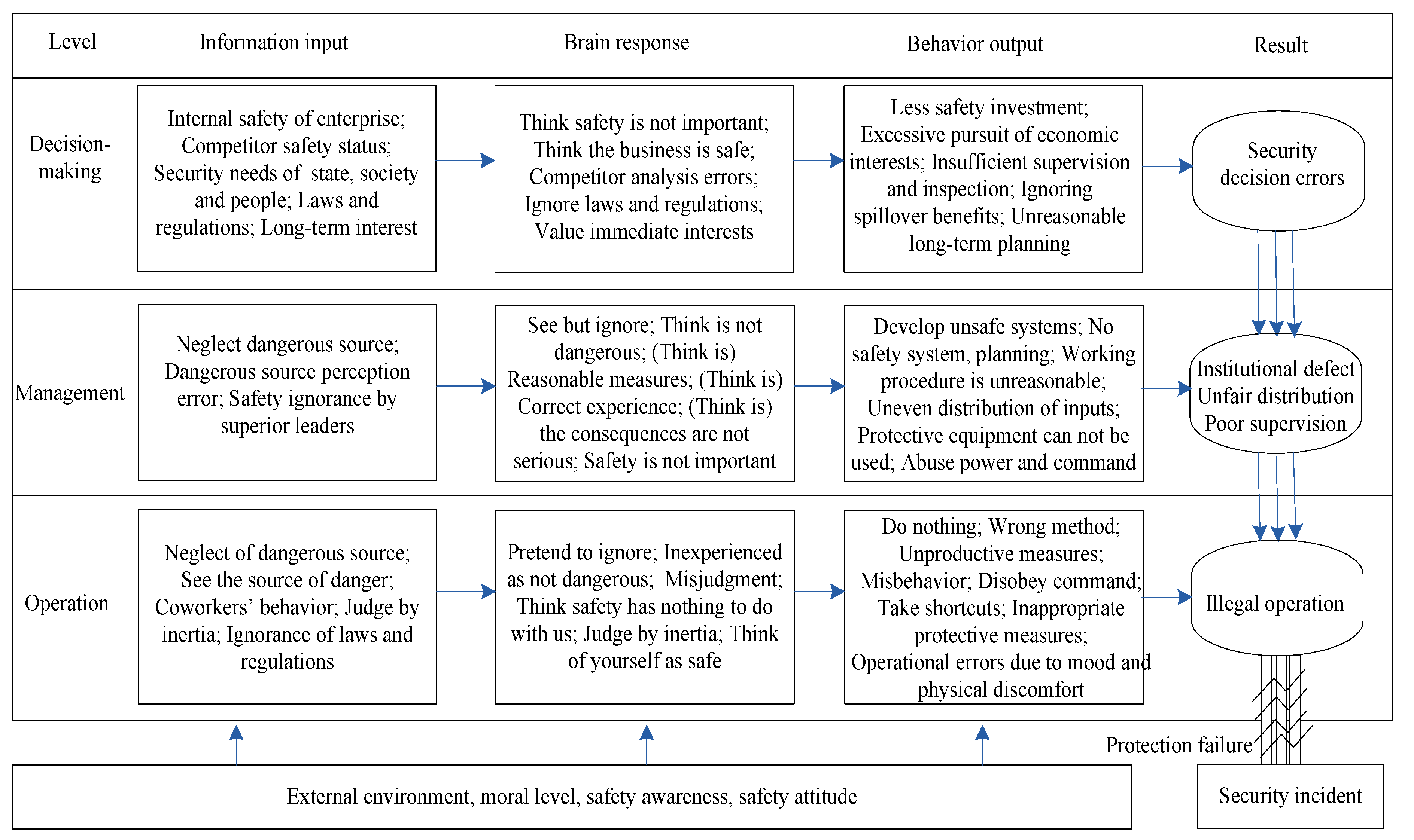
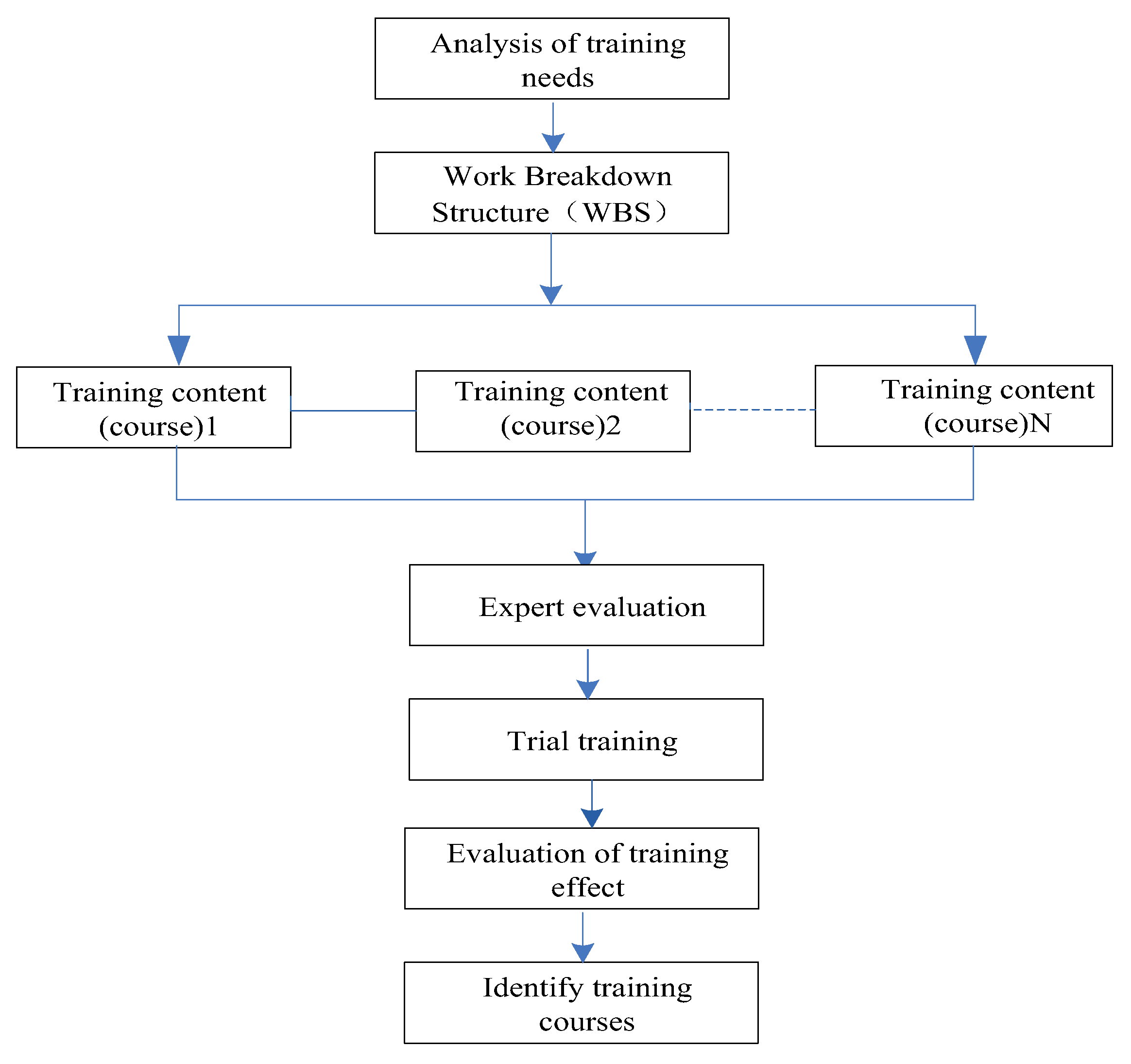
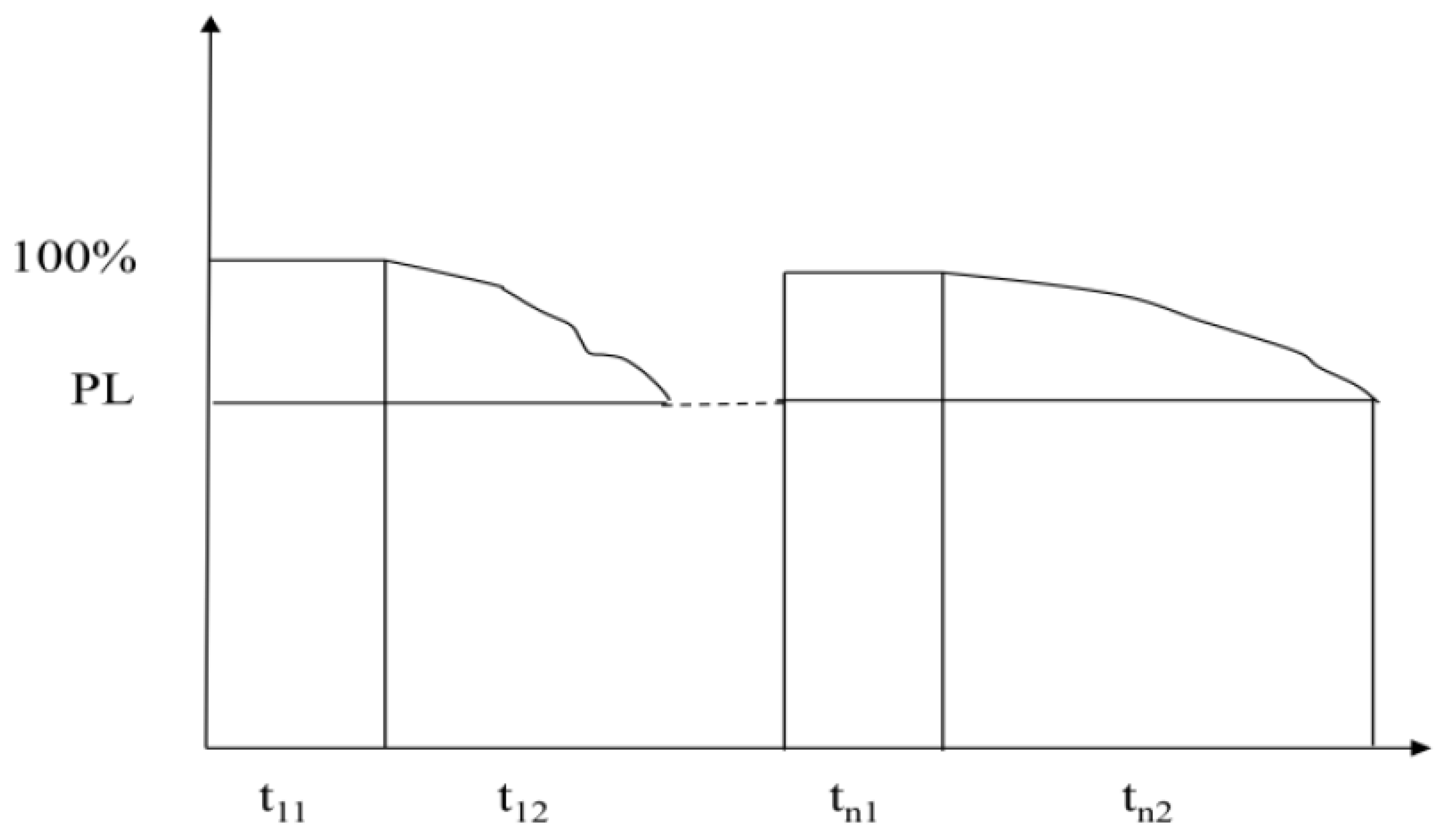
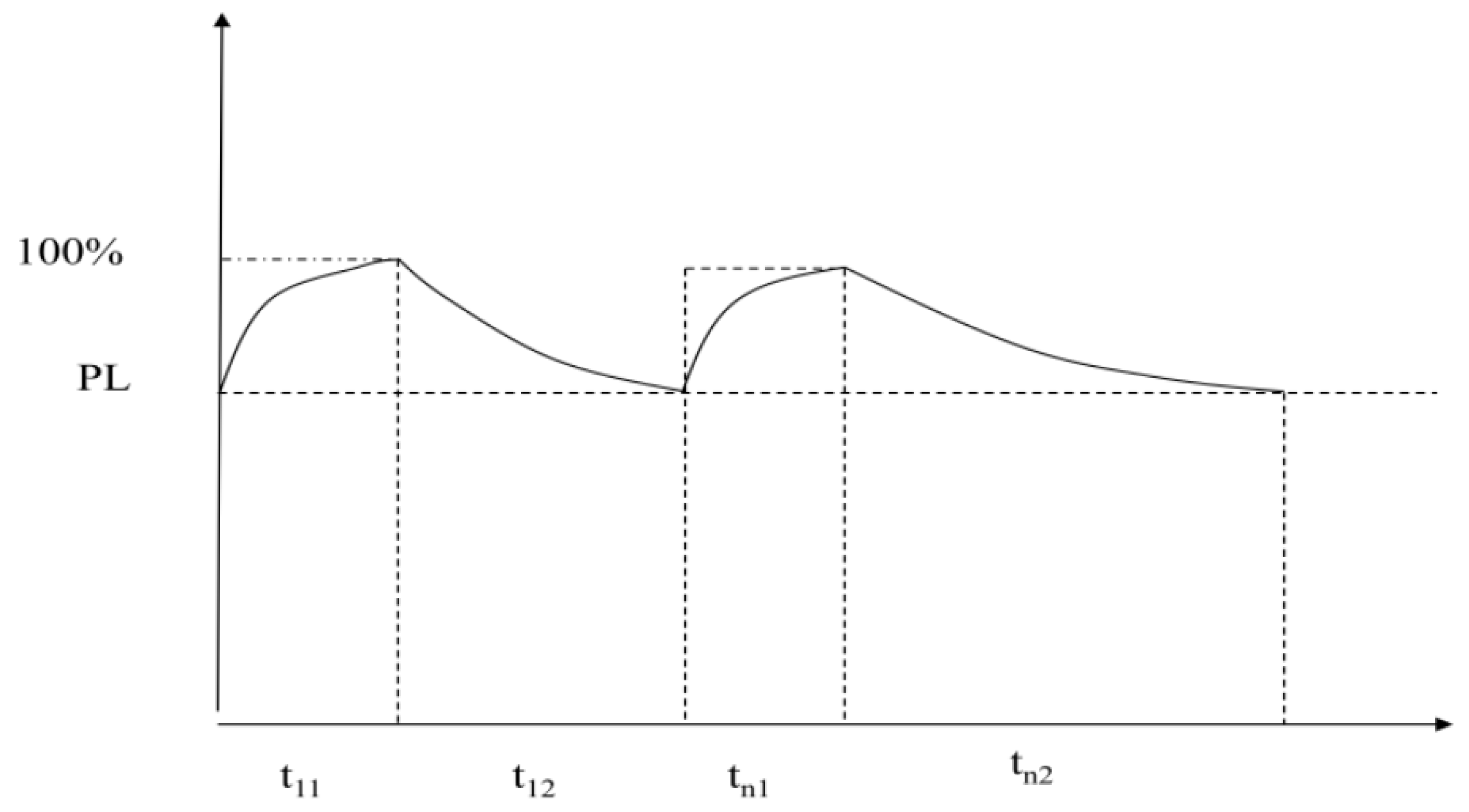
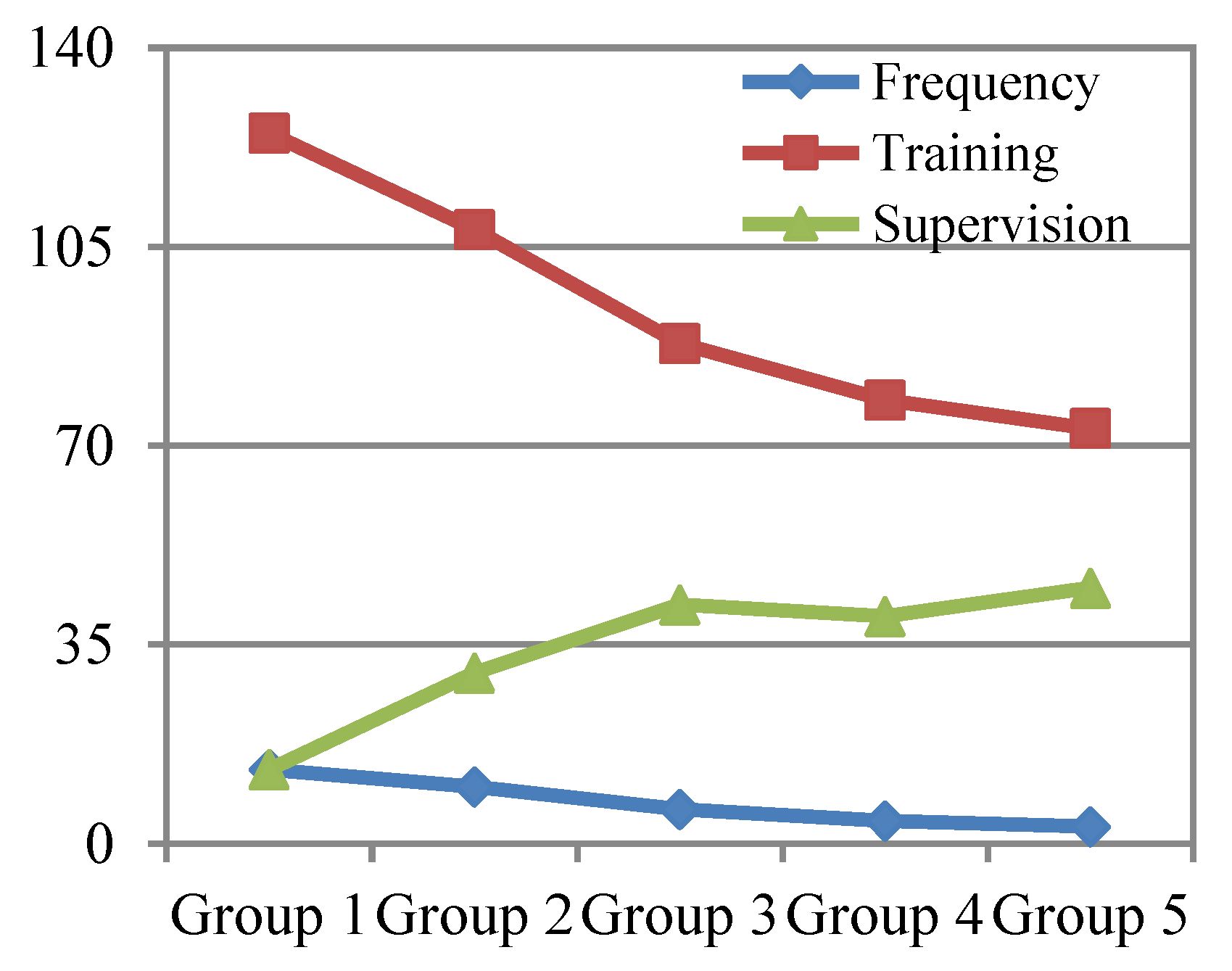

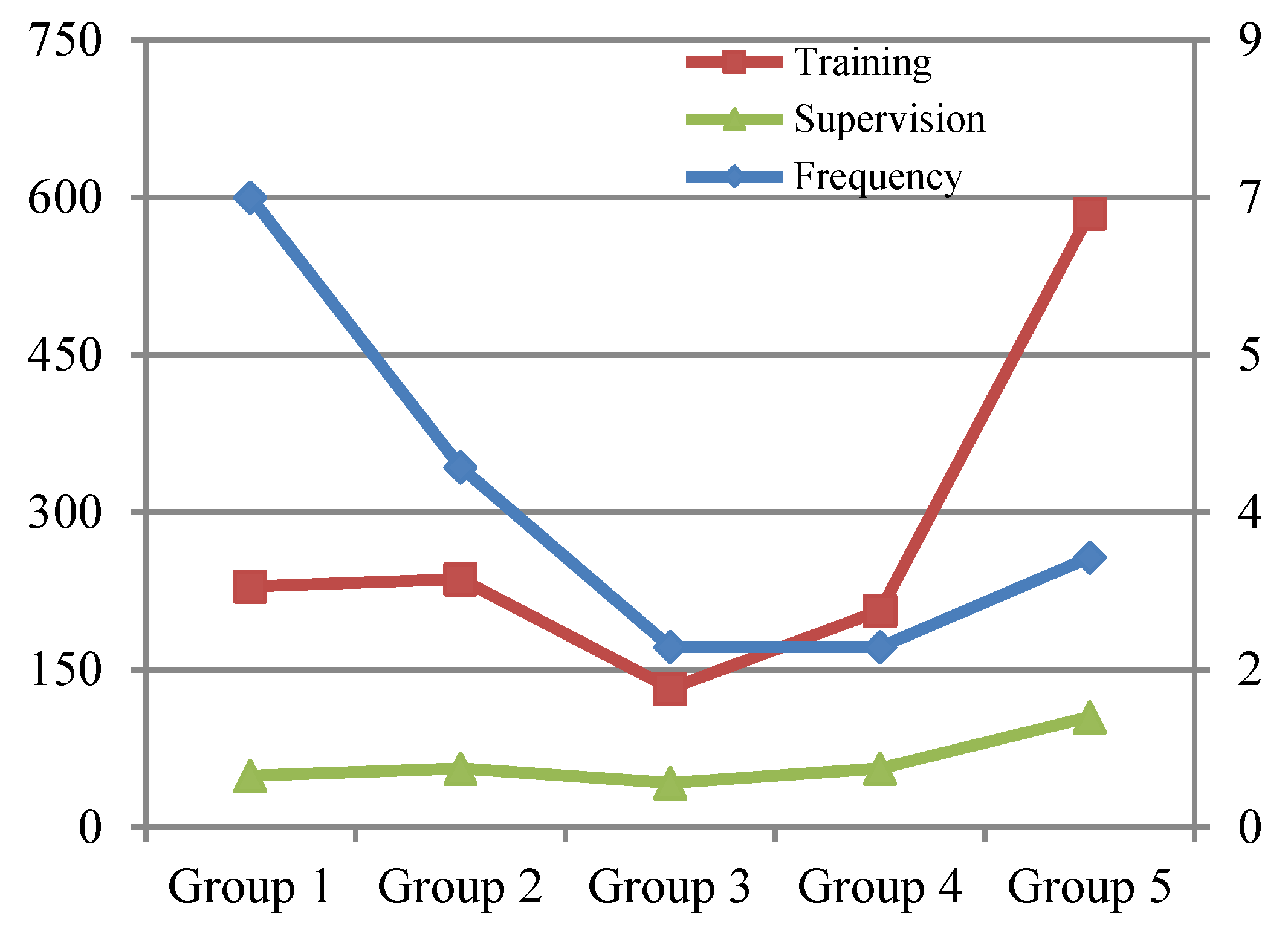
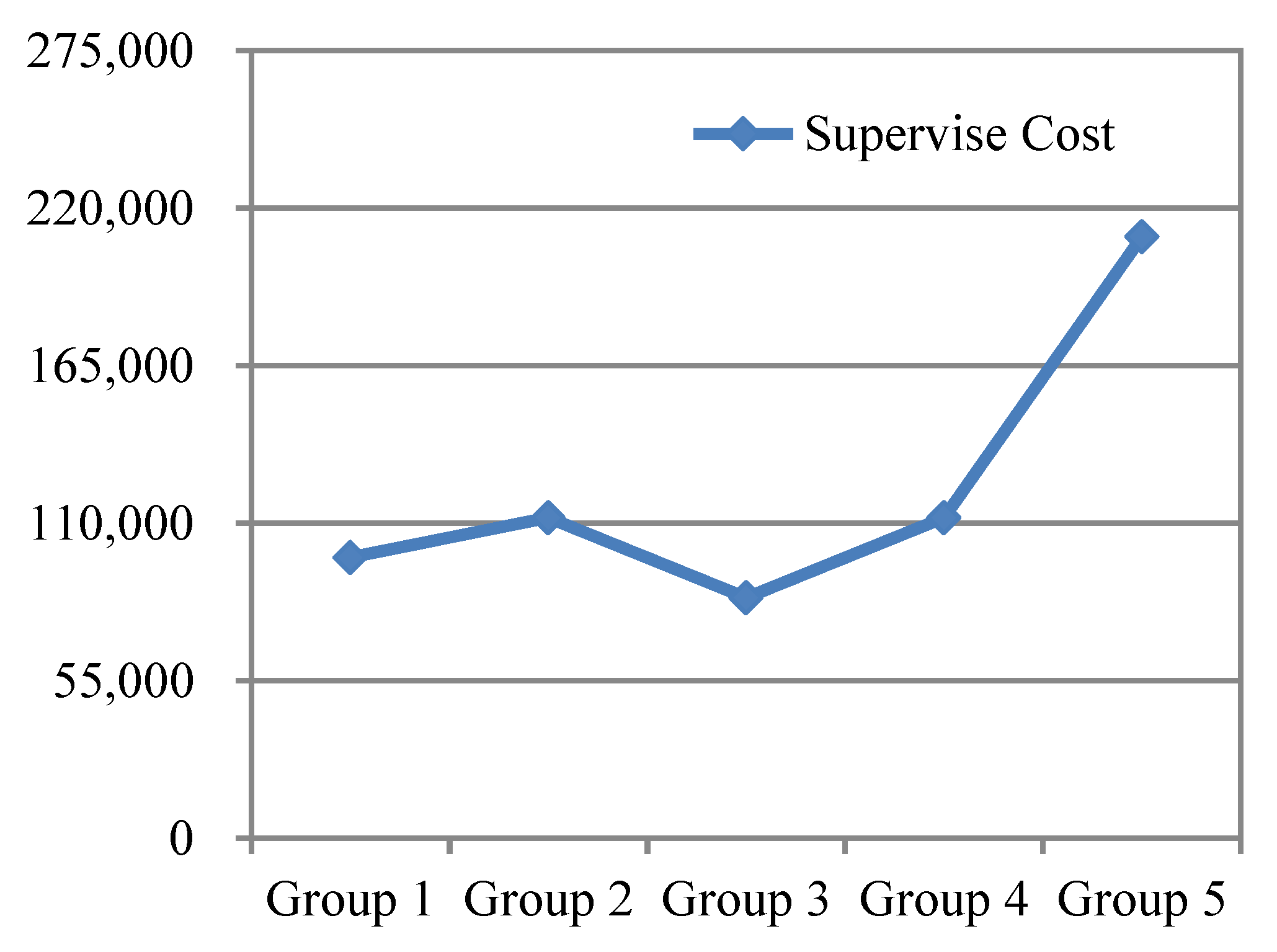
| Level | Training Requirements (Objectives) |
|---|---|
| Decision-making level | The philosophy of safety first, the economic outlook of safety as beneficial, the emotional outlook of respect for life and the scientific outlook of prevention |
| Management level | Safe management responsibilities, safety management skills and emergency management capabilities |
| Operation level | The attachment of great importance to safety, ensuring the safety operation conforms to the standard requirements and actively implementing the safety production |
| Object | Purpose | Contents |
|---|---|---|
| Enterprise decision-making level, such as legal representatives, party and government leaders, directors at all levels | Create the philosophy of safety first Create the emotional outlook of respect for life Create the economic outlook of safety being beneficial Instill the scientific outlook of prevention | Work safety guidelines, policies, laws and regulations Safety production management capability Correct security thinking Realistic work style Advanced safety production management experience Typical accident case analysis |
| Enterprise management, such as middle managers and grass-roots managers, team leaders | Increase awareness and senses of responsibility Increase care and attach importance to safe production Set a good example Support safety work | Work safety guidelines, policies, laws and regulations Employee safety production responsibility system In-depth analysis of typical accident cases Basic safety technical knowledge Policies, laws and regulations on work-related injury insurance Statistics, reports, investigation and treatment of casualties and occupational diseases On-site inspection techniques and temporary emergency measures Management of major hazard sources and preparation of emergency rescue plans Advanced safety production management experience |
| New employees (including contract workers), temporary workers, trainees, interns and students, etc. | Training and mastering of the basic skills required for the position | Three-level safety education On-site safety education Basic knowledge of production safety; rules and regulations of production safety of the unit; labor safety discipline; dangerous factors, preventive measures and emergency plans in production sites and public posts; accident cases, etc. Construction safety education The safety production status and rules and regulations of the section, district and team; dangerous factors, preventive measures and emergency measures existing in the production site and working positions; typical accident case analysis Team safety education Job safety operation rules; proper use of production equipment, safety devices and labor protection articles (appliances); specific accident cases, etc. |
| Special operations personnel for operations such as electrical work, metal welding cutting, lifting machinery, erection operations, refrigeration, blasting operations | Improve professional skills, hold the certification | Theoretical knowledge Actual operation Note: according to relevant national standards |
| Days | 1 | 2 | 3 | 4 | 5 | 6 | 7 | 8 | 9 | 10 | 11 | 12 | 13 | 14 | 15 | 16 | 17 |
|---|---|---|---|---|---|---|---|---|---|---|---|---|---|---|---|---|---|
| No.1 | 16 | 16 | 14 | ||||||||||||||
| No.2 | 16 | 17 | 16 | 14 | |||||||||||||
| No.3 | 17 | 17 | 16 | 15 | 14 | ||||||||||||
| No.4 | 18 | 17 | 17 | 17 | 16 | 15 | 14 | ||||||||||
| No.5 | 18 | 18 | 17 | 18 | 17 | 17 | 15 | 14 | |||||||||
| No.6 | 19 | 19 | 19 | 19 | 19 | 18 | 16 | 16 | 16 | 14 | |||||||
| No.7 | 19 | 19 | 19 | 18 | 18 | 19 | 19 | 19 | 15 | 16 | 14 | ||||||
| No.8 | 20 | 19 | 20 | 19 | 19 | 19 | 17 | 18 | 18 | 17 | 16 | 14 | |||||
| No.9 | 19 | 20 | 20 | 20 | 20 | 19 | 19 | 18 | 16 | 16 | 16 | 14 | |||||
| No.10 | 20 | 20 | 20 | 20 | 18 | 18 | 17 | 17 | 17 | 18 | 16 | 16 | 14 | ||||
| No.11 | 20 | 20 | 19 | 20 | 18 | 18 | 19 | 19 | 16 | 16 | 17 | 17 | 14 | ||||
| No.12 | 20 | 20 | 20 | 19 | 19 | 19 | 19 | 18 | 18 | 15 | 18 | 15 | 15 | 14 | |||
| No.13 | 20 | 20 | 20 | 20 | 20 | 19 | 19 | 20 | 20 | 18 | 19 | 19 | 20 | 19 | 18 | 19 | 20 |
| Days | 1 | 2 | 3 | 4 | 5 | 6 | 7 | 8 | 9 | 10 | 11 | 12 | 13 | 14 | 15 | 16 | 17 |
|---|---|---|---|---|---|---|---|---|---|---|---|---|---|---|---|---|---|
| No.1 | 18 | 18 | 16 | 14 | |||||||||||||
| No.2 | 18 | 19 | 18 | 16 | 14 | ||||||||||||
| No.3 | 19 | 18 | 18 | 18 | 15 | 14 | |||||||||||
| No.4 | 19 | 19 | 18 | 17 | 18 | 18 | 14 | ||||||||||
| No.5 | 19 | 19 | 19 | 17 | 17 | 16 | 15 | 15 | 14 | ||||||||
| No.6 | 20 | 20 | 20 | 18 | 19 | 19 | 18 | 17 | 17 | 14 | |||||||
| No.7 | 20 | 20 | 20 | 20 | 20 | 20 | 18 | 18 | 16 | 16 | 14 | ||||||
| No.8 | 20 | 20 | 20 | 20 | 19 | 20 | 17 | 17 | 17 | 15 | 15 | 14 | |||||
| No.9 | 20 | 19 | 20 | 18 | 18 | 20 | 20 | 18 | 18 | 16 | 16 | 15 | 15 | 14 | |||
| No.10 | 20 | 19 | 20 | 18 | 19 | 20 | 20 | 18 | 18 | 18 | 18 | 18 | 19 | 18 | 19 | 18 | 18 |
| Days | 1 | 2 | 3 | 4 | 5 | 6 | 7 | 8 | 9 | 10 | 11 | 12 | 13 | 14 | 15 | 16 | 17 |
|---|---|---|---|---|---|---|---|---|---|---|---|---|---|---|---|---|---|
| No.1 | 20 | 20 | 19 | 19 | 17 | 14 | |||||||||||
| No.2 | 20 | 20 | 20 | 17 | 18 | 17 | 14 | ||||||||||
| No.3 | 20 | 20 | 19 | 19 | 18 | 18 | 16 | 14 | |||||||||
| No.4 | 20 | 20 | 20 | 19 | 18 | 18 | 18 | 16 | 15 | 14 | |||||||
| No.5 | 20 | 20 | 20 | 19 | 18 | 18 | 18 | 19 | 19 | 18 | 16 | 16 | 14 | ||||
| No.6 | 20 | 20 | 18 | 19 | 19 | 20 | 20 | 19 | 19 | 19 | 20 | 19 | 20 | 17 | 18 | 19 | 18 |
| Days | 1 | 2 | 3 | 4 | 5 | 6 | 7 | 8 | 9 | 10 | 11 | 12 | 13 | 14 | 15 | 16 | 17 |
|---|---|---|---|---|---|---|---|---|---|---|---|---|---|---|---|---|---|
| No.1 | 20 | 20 | 19 | 19 | 19 | 20 | 18 | 14 | |||||||||
| No.2 | 20 | 20 | 20 | 20 | 19 | 19 | 16 | 16 | 16 | 14 | |||||||
| No.3 | 20 | 20 | 20 | 20 | 19 | 19 | 18 | 18 | 15 | 16 | 14 | ||||||
| No.4 | 20 | 18 | 19 | 20 | 20 | 20 | 19 | 19 | 20 | 20 | 17 | 18 | 20 | 18 | 19 | 20 | 19 |
| Days | 1 | 3 | 5 | 7 | 8 | 9 | 10 | 11 | 12 | 13 | 14 | 15 | 16 | 17 | 18 | 19 | 20 |
|---|---|---|---|---|---|---|---|---|---|---|---|---|---|---|---|---|---|
| No.1 | 20 | 20 | 20 | 20 | 20 | 20 | 20 | 20 | 18 | 16 | 14 | ||||||
| No.2 | 20 | 20 | 20 | 20 | 20 | 19 | 19 | 19 | 18 | 18 | 14 | ||||||
| No.3 | 20 | 20 | 20 | 19 | 19 | 18 | 18 | 19 | 19 | 19 | 20 | 20 | 19 | 19 | 20 | 20 | 18 |
| Days | 1 | 3 | 5 | 7 | 9 | 11 | 13 | 15 | 17 | 19 | 21 | 23 | 25 | 27 | 29 | 30 |
|---|---|---|---|---|---|---|---|---|---|---|---|---|---|---|---|---|
| No.1 | 18 | 18 | 17 | 15 | 16 | 17 | 15 | 14 | 14 | 14 | 13 | 13 | 12 | 12 | 11 | 12 |
| No.2 | 17 | 18 | 16 | 17 | 16 | 15 | 17 | 16 | 16 | 15 | 15 | 15 | 14 | 14 | 13 | 13 |
| No.3 | 19 | 18 | 19 | 18 | 19 | 18 | 17 | 16 | 18 | 16 | 17 | 16 | 16 | 16 | 15 | 15 |
| No.4 | 20 | 19 | 19 | 18 | 18 | 17 | 17 | 17 | 17 | 16 | 16 | 16 | 17 | 15 | 15 | 15 |
| No.5 | 19 | 19 | 20 | 19 | 18 | 19 | 17 | 18 | 18 | 18 | 18 | 17 | 17 | 17 | 17 | 16 |
| No.6 | 20 | 20 | 20 | 20 | 19 | 19 | 19 | 19 | 18 | 17 | 18 | 18 | 17 | 18 | 17 | 17 |
| No.7 | 20 | 20 | 19 | 20 | 19 | 19 | 20 | 19 | 20 | 19 | 20 | 20 | 20 | 19 | 19 | 20 |
| Days | 2 | 6 | 10 | 14 | 18 | 22 | 26 | 30 | 34 | 38 | 42 | 46 | 50 | 54 | 58 | 60 |
|---|---|---|---|---|---|---|---|---|---|---|---|---|---|---|---|---|
| No.1 | 17 | 18 | 16 | 17 | 16 | 15 | 17 | 16 | 17 | 17 | 16 | 16 | 16 | 16 | 15 | 14 |
| No.2 | 19 | 18 | 19 | 18 | 19 | 18 | 17 | 16 | 18 | 17 | 16 | 16 | 16 | 17 | 16 | 15 |
| No.3 | 20 | 20 | 19 | 20 | 18 | 19 | 17 | 17 | 18 | 16 | 17 | 18 | 17 | 18 | 17 | 18 |
| No.4 | 20 | 19 | 20 | 18 | 19 | 20 | 18 | 19 | 20 | 20 | 19 | 18 | 20 | 20 | 20 | 19 |
| Days | 3 | 9 | 15 | 21 | 27 | 33 | 39 | 45 | 51 | 57 | 63 | 69 | 75 | 81 | 87 | 90 |
|---|---|---|---|---|---|---|---|---|---|---|---|---|---|---|---|---|
| No.1 | 20 | 19 | 19 | 19 | 19 | 19 | 19 | 18 | 18 | 18 | 18 | 18 | 18 | 16 | 17 | 17 |
| No.2 | 20 | 20 | 19 | 20 | 19 | 20 | 19 | 20 | 20 | 19 | 20 | 20 | 19 | 20 | 19 | 20 |
| Days | 5 | 15 | 25 | 35 | 45 | 55 | 65 | 75 | 85 | 95 | 105 | 115 | 125 | 135 | 145 | 150 |
|---|---|---|---|---|---|---|---|---|---|---|---|---|---|---|---|---|
| No.1 | 20 | 20 | 20 | 20 | 20 | 19 | 19 | 19 | 18 | 19 | 18 | 17 | 16 | 17 | 16 | 17 |
| No.2 | 20 | 20 | 20 | 20 | 20 | 20 | 20 | 20 | 19 | 20 | 20 | 19 | 20 | 19 | 19 | 20 |
| Days | 8 | 24 | 40 | 56 | 72 | 88 | 104 | 120 | 136 | 152 | 160 | 184 | 200 | 216 | 232 | 240 |
|---|---|---|---|---|---|---|---|---|---|---|---|---|---|---|---|---|
| No.1 | 20 | 20 | 20 | 20 | 20 | 20 | 20 | 20 | 19 | 19 | 19 | 19 | 18 | 18 | 17 | 17 |
| No.2 | 20 | 20 | 19 | 20 | 19 | 19 | 20 | 20 | 19 | 18 | 18 | 18 | 18 | 18 | 17 | 16 |
| No.3 | 20 | 20 | 20 | 20 | 19 | 20 | 20 | 20 | 19 | 20 | 19 | 19 | 20 | 20 | 20 | 19 |
Publisher’s Note: MDPI stays neutral with regard to jurisdictional claims in published maps and institutional affiliations. |
© 2022 by the authors. Licensee MDPI, Basel, Switzerland. This article is an open access article distributed under the terms and conditions of the Creative Commons Attribution (CC BY) license (https://creativecommons.org/licenses/by/4.0/).
Share and Cite
Liu, X.; Li, X. Exploring the Formation Mechanism of Unsafe Construction Behavior and Testing Efficient Occupational Health and Safety (OHS) Programs. Int. J. Environ. Res. Public Health 2022, 19, 2090. https://doi.org/10.3390/ijerph19042090
Liu X, Li X. Exploring the Formation Mechanism of Unsafe Construction Behavior and Testing Efficient Occupational Health and Safety (OHS) Programs. International Journal of Environmental Research and Public Health. 2022; 19(4):2090. https://doi.org/10.3390/ijerph19042090
Chicago/Turabian StyleLiu, Xun, and Xiaobo Li. 2022. "Exploring the Formation Mechanism of Unsafe Construction Behavior and Testing Efficient Occupational Health and Safety (OHS) Programs" International Journal of Environmental Research and Public Health 19, no. 4: 2090. https://doi.org/10.3390/ijerph19042090
APA StyleLiu, X., & Li, X. (2022). Exploring the Formation Mechanism of Unsafe Construction Behavior and Testing Efficient Occupational Health and Safety (OHS) Programs. International Journal of Environmental Research and Public Health, 19(4), 2090. https://doi.org/10.3390/ijerph19042090






